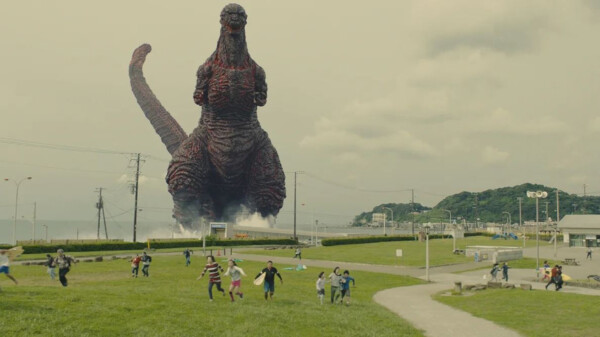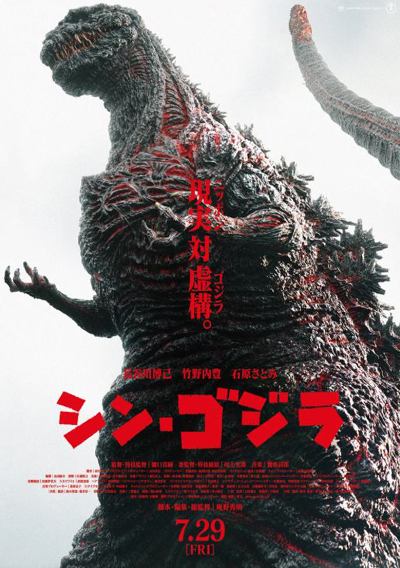Del and Mladen review ‘Shin Godzilla’

Image courtesy of Toho Studios.
“Shin Godzilla” Starring Hiroki Hasegawa, Satomi Ishihara, Satomi Ishihara, Ren Ôsugi and others. Directed by Shinji Higuchi and Hideaki Anno. Two hours. Rated PG-13. Theatrical release.
Plot summary: Radioactive waste dumped in the ocean leads to the creation of the god-like kaiju Godzilla, who crashes ashore in Tokyo and threatens to destroy mankind. Japanese bureaucrats must overcome their own inertia and world opinion to deal with the threat.
Spoilers: This movie was released in 2016. The plot is already known.
Del’s take
I’m a casual fan of Godzilla, the lizard with a thyroid problem. Mladen is an obsessed super-fan. He will perceive anything I say about this film that suggests it was less than perfect as a personal insult, so I’m treading carefully, unlike Godzilla, who stomps through Tokyo knocking down buildings, crushing trains and torching the rubble with his radioactive oral and dorsal scute rays. And you thought iguanas falling out of trees was a big deal.
“Shin Godzilla” was originally released in 2016, before its much better successor “Godzilla Minus One,” but it has been revived in a 4K re-release showing in theaters across North America. It was at one such showing, at the AMC theater in Destin Commons, that Mladen, Dusty and I renewed our acquaintance with the leviathanic reptile. Is “leviathanic” a word? If not, I’m making it a word.
In Japanese, “Shin Godzilla” means “New Godzilla” or “True Godzilla,” but it can also mean “God” as in the giant, city-destroying lizard has become an actual deity, in this case a very pissed-off deity. No wonder those deep South charismatic churches molest snakes – Godzilla is extremophile Pentecostal.
But seriously. To my knowledge Godzilla has always operated as a symbol for the dangers of nuclear energy. But in “Shin Godzilla” I see refrains of the 2011 earthquake and tsunami that led to the disaster at the Fukushima reactor complex. It reminds me of “The Days,” a Netflix miniseries about the response to Fukushima.
And therein lies the problem: Just as the monster continuously evolves in “Shin Godzilla,” so does the message, away from the original and simple metaphor for atomic bomb = bad to a whole lot of other crap that frankly, I thought was boring. In “Shin Godzilla” the subtext is not just about earthquakes and tsunamis but the manmade disasters of paralyzing bureaucracy, political ass-covering and ambition fueled by hubris – with a bit of nationalistic grousing thrown in for good measure.
The movie focuses less on monster mayhem than endless meetings where bureaucrats debate the positives and negatives of every action. They seem reluctant to make decisions, not because it’s the right or wrong thing to do – they’re more concerned about the political ramifications and what the world might think, particularly the United States, which in “Shin Godzilla” exists as a quixotic and unpredictable drunk uncle. When the Japanese government finally takes action, Godzilla evolves to present new problems. The final scene of the movie hints at one of those new problems.
There’s way, way, waaaay too much talking, and as Dusty pointed out afterwards, all that talk meant reading lots and lots of subtitles, which at times distracted from the action on the screen. I had the same problem. I use subtitles on all my movies so I’m a fast and experienced reader, but at times “Shin Godzilla” overwhelmed my ability to keep up.
Having seen “Godzilla Minus One” before “Shin Godzilla” I can’t help but make comparisons. “Godzilla Minus One” was a more personal and relatable story, and it was told in a way that made me care about the people and events. “Shin Godzilla” tried to be “All the President’s Men” and I didn’t care. We know bureaucracy is bad. We know ass-covering is bad. Do we really need a movie about that? I’d rather see the monster kicking over skyscrapers.
Both movies provide dazzling special effects although again, I’d give the nod to “Godzilla Minus One,” along with kudos for its score. Mladen rhapsodized about the score for “Shin Godzilla” but to me it was nothing special, though I do appreciate the nods to the traditional Godzilla score.
Overall “Godzilla Minus One” leaves more of an impression than “Shin Godzilla” and in that context the former is a better story than the latter. The problem with “Shin Godzilla” is its focus on bureaucratic inertia kills the narrative drive. The movie is like a car that starts, runs for a minute and then conks out for 10 minutes before starting again. I found the meeting segments to be boring and even irritating because not even the most loathsome career apparatchik would stop to debate how a natural disaster might affect his personal fortunes as the carnage is swirling around him.
In my review of “Godzilla Minus One” I gave the movie a grade of A-. I’ll stand by that. It’s not a perfect movie but it’s pretty damn good. “Shin Godzilla” gets a B-. Special effects are decent and bully to the writers for trying to make the story more provocative. But their focus on demonizing bureaucracy and politics gets in the way of telling what could be a fun story. The movie is its own kind of bureaucracy.
And now I remand custody of this review to Mladen, who can’t be blamed for what he’s about to say. They make pills to fix that, but you know how it is trying to get crusty old farts to take their pills.
Mladen’s take
Reckon calling Del a blasphemer, heretic, scoundrel, and blackguard is now impossible. I expected his “Shin Godzilla” review to be anti-kaiju, anti-Godzilla fanboy, and anti‑Mladen. Instead, Del compliments me by labeling me an “obsessed super-fan” and then provides our dear readers a lackadaisical, oh-so-moderate, and incorrect take on one of the 10 best films ever made.

To Del and the rest of America, the poser president is using bureaucracy to cripple, if not annihilate, our democracy. Never underestimate the power that Big Government institutions have to misshape our lives. The way the Japanese federal government is portrayed in “Shin Godzilla” is plausible. That plausibility adds an astonishing bit of realism to an otherwise absurd premise: a 300-meter-tall animal capable of directed, real‑time mutation to protect its life emerges from the sea to trample a city. What a glorious trampling it is.
In “Shin Godzilla,” the government and its enablers, the civilian and military bureaucracies, treat the monster as a natural disaster. Godzilla is a flesh and blood typhoon or earthquake and, like a typhoon or earthquake, it shows no animosity toward humans. People and their structures are just in the way of a phenomenon generated by the environment. Had the humans left the creature alone, it would’ve caused less damage than the decision by a different bureaucracy to Iran-nuclear-site the beast. “Iran-nuclear‑site the beast?” you ask. See the movie and you’ll know what I mean. You will be enraptured. The scene is one of the greatest 30 seconds of action of all time in any movie anywhere to infinity. Dang, that last sentence must’ve been my obsessed super‑fan side erupting.
Yes, “Shin Godzilla” has an itsy-bitsy flaw or two.
Dusty via Del noted one of them. The movie is in Japanese with no English dubbing. You must read the captions and, sometimes, the captions get lost amid the pictures on the screen.
The other problem, and it’s significant, is the film’s soundscape. For some reason, I imagine it was to save money, the film is recorded in a mere three channels or some such defect. All the gunfire, exploding trains, toppling buildings, and Godzilla’s radiation ray blasts come at you from the front. There’s no sound moving left to right, right to left, back to front, or front to back. Most tragic of all? No booming near-infrasound to jostle my guts. Just can’t figure out the crappy sound recording, though I have no choice but to forgive Toho Studios.
The lack of vibrant, vivid, and vivacious noise amid all the chaos of a metropolis taking it on the chin is somewhat offset by the “Shin Godzilla” soundtrack. It pays due respect to Akira Ifukube’s masterful compositions for the original 1954 “Godzilla.” That’s vital because “new” Godzilla is a very effective re-imagination of the “Gojira” of old.
“Shin Godzilla” is an A. Man, I hope I’m alive to see the sequel and it better damn well be recorded in Dolby Atmos (or its successor). Godzilla deserves nothing but the best.
Mladen Rudman is a former journalist and technical writer. Del Stone Jr. is a former journalist and writer.
![]()
Leave a Reply